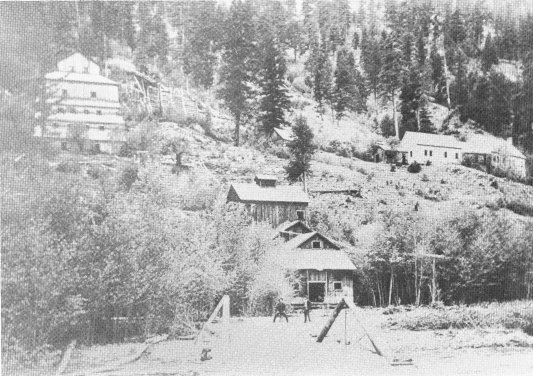
![]()
What Became of The Wagonload of Ruby Silver?

Ruby Mill in the top left corner of this photo in the days when the boomtown was a vigorous mining camp. It was in this community that many of the “firsts” of Okanogan County took place. But low-grade ore from Ruby Hill, lack of adequate transportation, and distance from processing centers made the operation marginal at best. When government support of silver prices was removed in 1893, the town was doomed. Today the forest has returned to its primeval quiet, and only old foundations indicate what once happened here.
The year was 1888. And, within a brief period of time, the boomtown of Ruby in Washington Territory had become one of the liveliest and best known mining camps in the Pacific Northwest. Ruby City was built up solidly for over a quarter of a mile on each side of a single rutted dirt road. Therein rested over a half dozen saloons, many in which gunfights were reportedly commonplace. Its inhabitants, mostly miners, experienced fires, floods, and the fear of marauding Indians on the warpath.
The mill foreman of the Ruby gold and silver mill, Thomas D. Fuller, heard the pounding of horses’ hooves and the whistle of the wagon’s master. It had become the familiar signal for the mill foreman to open the thick wood mill doors. This enabled the heavily armed workers to carry and load heavy brown sacks of silver onto freight wagons. Two other wagons would be loaded with the same brown sacks. In order to fool hijackers, these sacks would sometimes be filled with sand, not silver.
The mill’s foreman unbolted the door and threw it open. However, it was not the wagon master outside. Four masked, armed desperados roughly shoved the mill foreman aside using the butts of their guns. One of the men hurled the startled foreman into the dirt and jabbed his gun barrel to the foreman’s head. Still, one of the other masked men rushed toward the brown sacks of silver and sand. They lifted the sacks carefully to make sure they were getting the silver and not the sand. Somehow, these bandits knew that the silver sacks were always heavier.
The desperados dragged the sacks outside and heaved them onto a long string of waiting packhorses. Then they re-entered the mill for more silver. The masked men whispered gruffly to one another. Not one sack of silver was left in the mill. The four robbers were getting nervous, and were anxious to leave. One of them nodded toward the mill foreman who was still pinned against the ground by the barrel of one of their gunmen. Suddenly, there was a gunshot. The mill foreman twitched grotesquely then lay still. He was dead.
The masked men leaped onto their horses, following Salmon Creek in the direction of Conconully, their pack animals straining under the heavy load of silver.
However, residents of Ruby City, being a half-mile away, had heard the gunshot. Soon the sheriff, Robert Allison, and his posse of about 25 men were hot on the trail of the fleeing robbers. The posse hoped to apprehend the four men before they reached Conconully.
When the posse started down Salmon Creek, they realized the robbers had never gotten that far. They backtracked and discovered that the four desperados had crossed the creek and slipped into the high country of Ruby Ridge.
The posse followed the trail of the robbers to the town of Loop Loop a couple miles west of Ruby. There, just outside of town the robbers stashed their silver and headed for the Last Chance Saloon in the same town.
Yes, four men had been there with packhorses. After spending several hours in the saloon and resting their horses the robbers had told the bartender that they had struck the mother lode, and that they were afraid someone was following them who wanted to steal their silver.
The posse followed the outlaws’ trail through Loop Loop Valley, back over Ruby Hill, down to Salmon Creek and Riverside on the Okanogan River. There, the posse found the horses and saddles of the four masked men. Unfortunately, the silver and the bandits had disappeared. Just one question plagued the posse now. Without the horses, how did these bandits carry all of that silver?
Not a trace of the robbers was ever found. Many people thought that the silver must have been hidden in the Okanogan River, because for years afterwards in that spot, one could dig into the bottom of the river and bring up gold and silver.
The burning question from yesteryear still remains. Does the silver still remain stashed somewhere out side the lost mining town of Loop Loop? Some folks believe the mastermind behind this heist was the desperado Frank Watkins from Riverside.
Today, the river and its lost mining town still guard its secrets.
Information for this article was compiled, researched, and written by Jerry Smith © 2007 Boom Towns & Relic Hunters.
![]()
